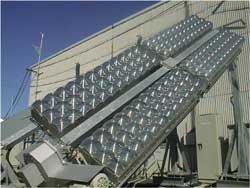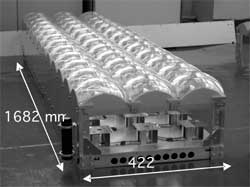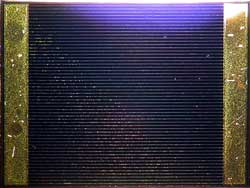About Syracuse.
This web-site is home to the work being performed in Japan on high efficiency concentrator photovoltaic (PV) power generation. This work has resulted in the achievement of a cell efficiency of 37% AM1.5G and a module efficiency of 27%. A brief introduction to the concentrator system is given below and pictures of various elements of the system shown on the right. More details can be found in the conference papers that are available in the downloads section.
What is concentrator PV and why is it important?
The motivation for developing high efficiency photovoltaic concentrator systems is to generate the maximum electrical power with the minimum of roof space and to lower the cost of photovoltaic power generation. The concept of concentrator photovoltaics is to use a lens to focus the sunlight onto a small but highly efficient solar cell. In this way sunlight can be collected from a large area using cheap materials, such as plastic, but the power conversion is performed by a specialised high performance solar cell. The concentrator system described on this web-site has a concentration ratio of 400X, meaning that the area over which sunlight is collected is 400 times larger than the area covered by the solar cells. The concentrator system described here uses triple junction InGaP/InGaAs/Ge cells that are usually used on spacecraft and would be prohibitively expensive for terrestrial application if they were used alone. However, the use of lenses made from readily manufacturers materials greatly reduces the area of expensive solar cell that is required, lowering the cost sufficiently that high efficiency photovoltaics can be used for terrestrial applications. The use of high efficiency PV is particularly important when roof space is limited, as it is desirable to generate as much power as possible from a small area.
Key features of the concentrator module
The solar cell used in the concentrator modules is the triple junction InGaP/InGaAs/Ge cell that has attained a maximum efficiency of 38.9% under 200X AM1.5G. The low loss tunnel junction interconnects and precise lattice matching are some of the features that has enabled such a high efficiency to be attained. The cell is manufactured at Sharp Corporation using metal organic vapour phase epitaxy (MOVPE).
The dome shaped Fresnel lens used in the concentrator system has been optimised as a low loss collector. A key breakthrough in the development of the lens was the successful injection moulding of the lens at Daido Metal. This process allows a rapid and inexpensive means for manufacturing high quality lenses that are sufficiently durable for use in a concentrator system.
The concentrator module is designed with ease of assembly in mind. All the technologically complex components are packaged into a receiver so that a series of receivers and lenses can be assembled with standard tools, using local materials and workforce. The concept is similar to the computer and automobile assembly industries, where key components are imported but the product assembled locally. It is anticipated that this approach will reduce the manufacturing cost of the module.
Current Activities
Outdoor evaluation and reliability testing, optimization of the module design.
Lens and cell development to reach higher concentration and improve efficiency.
Development of a computer model to predict the performance of the concentrator system.
Why the name Syracuse?
Archimedes is thought to have defended his home Syracuse in Sicily from invasion by focusing sunlight onto the boats of invading armies, thereby setting them alight. While we hope the concentrator system described here will be used for peaceful purposes, it seemed fitting to name the concentrator computer modelling program after this city. You can learn more about the legend of Archimedes and his role in solar energy elsewhere.
Acknowledgements
This work was supported by the Incorporated Administrative Agency New Energy and Industrial Technology Development Organisation (NEDO) under the Ministry of Economy, Trade and Industry (METI). The work is partially supported by the Ministry of Education, Culture, Sports, Science and Technology as a Private University Academic Frontier Research Center Program "Super High-Efficiency Photovoltaic Research Center".
<--
Please bookmark this page as: www.syracuse-pv.webhop.org
Last updated Monday, August 1, 2005
|

400X Concentrator System, installed at Inuyama, Japan

400X concentrator module body.

Receiver package. A glass homogenizer is located below the aperture and is attached to the solar cell at the bottom of the receiver.

37% efficient 7mmx10mm triple junction solar cell. Top contact pads are located at the sides of the cell and thin grid lines run across the optical window.
|

